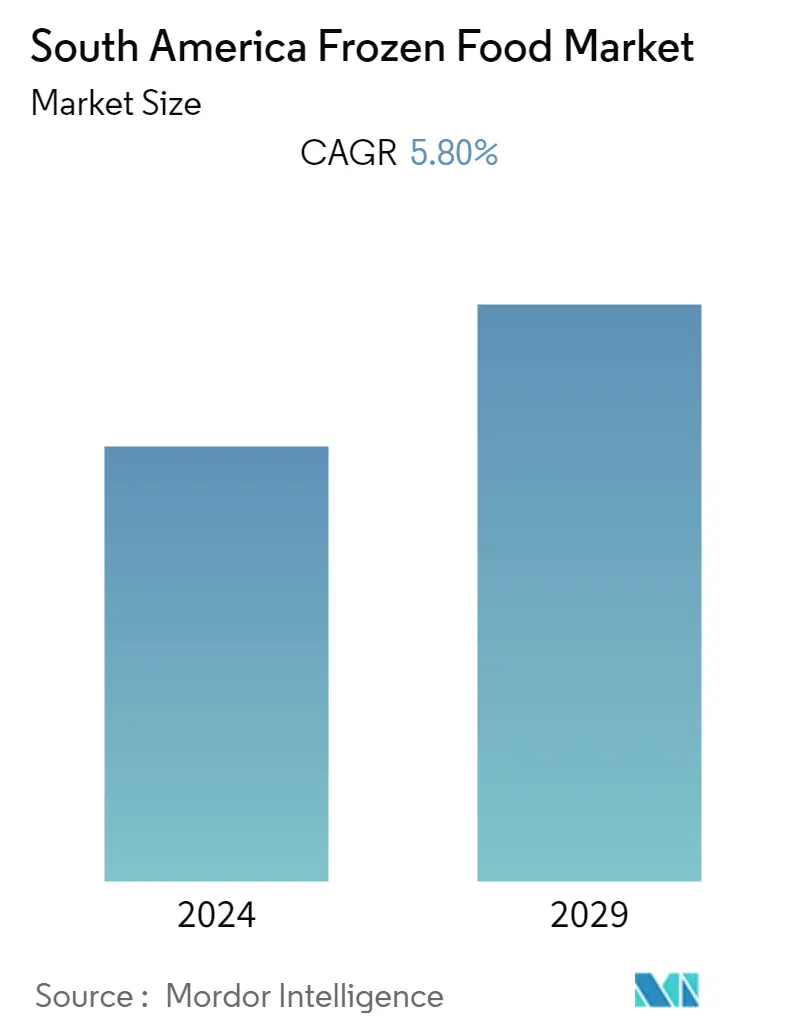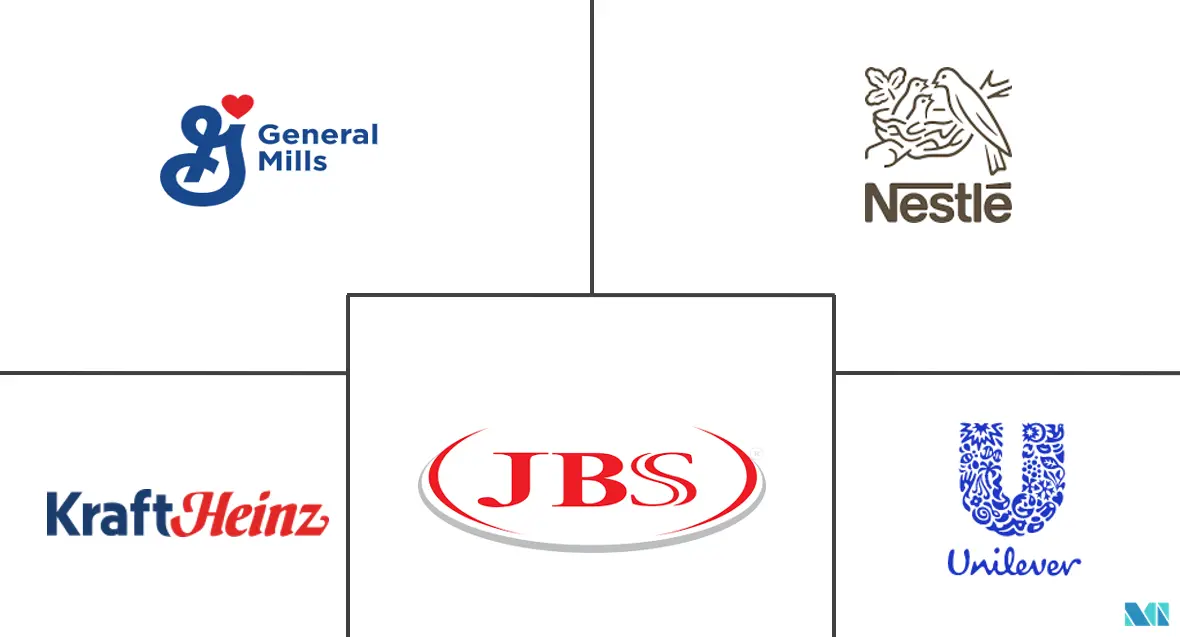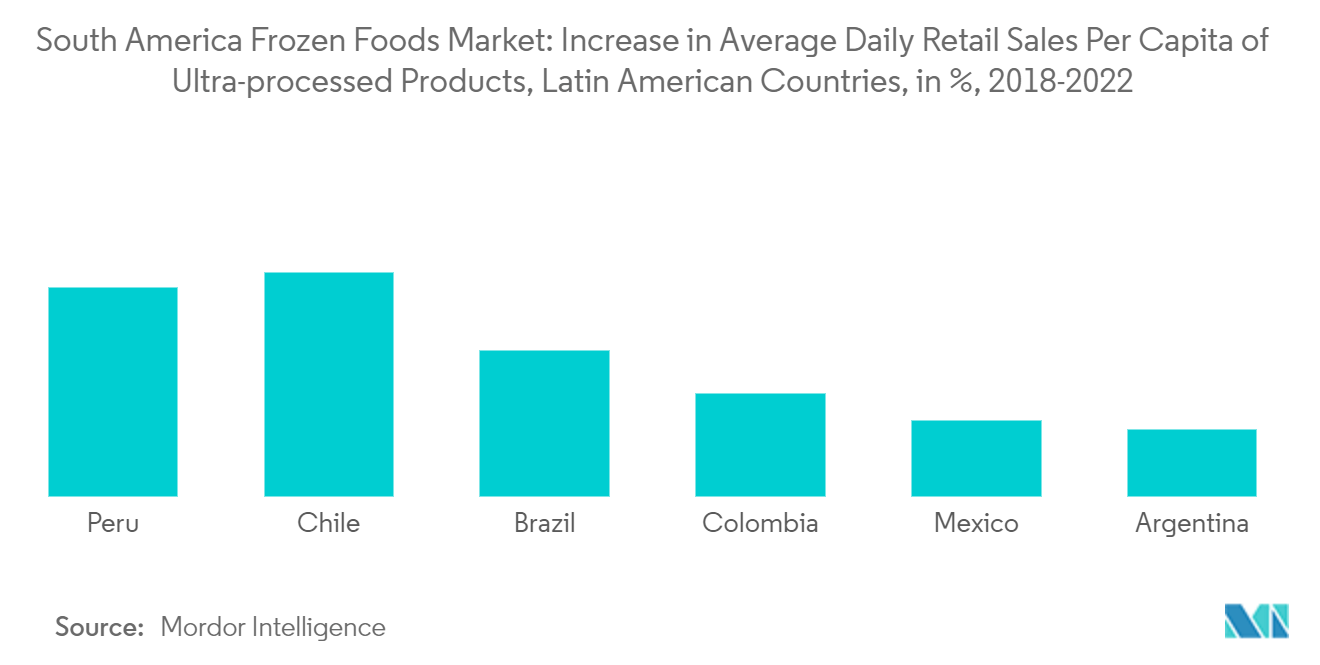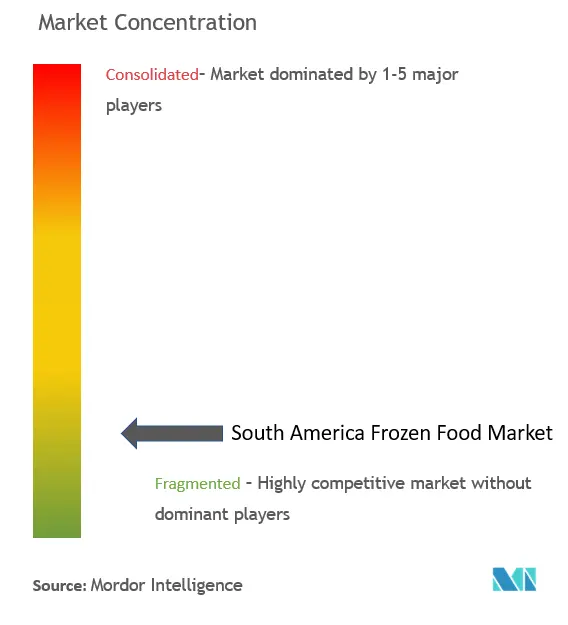South America Frozen Food Market Size

| Study Period | 2019 - 2029 |
| Base Year For Estimation | 2023 |
| Forecast Data Period | 2024 - 2029 |
| Historical Data Period | 2019 - 2022 |
| CAGR | 5.80 % |
| Market Concentration | Low |
Major Players
*Disclaimer: Major Players sorted in no particular order |
South America Frozen Food Market Analysis
The South American frozen food market is projected to register a CAGR of 5.8 % during the forecast period.
The advantages of frozen food and the strong backing for technological innovation have made the items more widely available and reasonably priced for consumers in South America. Frozen food is becoming more affordable as a result of the development of new technology. Frozen food manufacturers have been appealing to consumer demand by adding variety, innovating new flavors to make frozen foods, such as poultry, seafood, desserts, etc., more palatable, adjusting portion sizes, providing organic options, and expanding health benefits, such as fiber content. There is a shift toward demand for functional foods as consumers use food to address health issues or contribute to their overall health and well-being. Additionally, the ease of use, higher shelf life, and the busy lifestyle of consumers across the region also propel the growth of the market studied.
The COVID-19 pandemic influenced market growth as people inclined more toward foods with longer shelf lives. Supply chains also shifted production away from food service and into the retail sector. Both large and small manufacturers witnessed increased sales in 2020, but changes in packaging and distribution methods benefitted major manufacturers. Furthermore, the pandemic raised consumer demand for products that are focused on health and nutrition.
South America Frozen Food Market Trends
This section covers the major market trends shaping the South America Frozen Food Market according to our research experts:
Increase in Consumer Expenditure on Convenience Food Products
The market is primarily driven by rising expenditure on food and beverages, the introduction of products with longer shelf lives, increasing impulse purchasing, and growing demand for convenience foods that can be prepared quickly due to a shortage of available time. These factors have resulted in the need to stockpile eatables in houses that last for a longer duration without spoilage, which further increased frozen food sales. For instance, in February 2021, the American Frozen Food Institute (AFFI) reported that the sales of frozen meals, such as seafood and poultry, were 25.0% higher when compared to 2019, with an increase in sales of all types of frigid/chilled meals across South America. Due to the rise in the economy, growing working-class population, and evolved consumer lifestyle, a notable rise is observed in the expenditure for convenience food products, such as frozen foods, across South America.
Due to the fast-paced lifestyles and the need for a quick meal or snack, there has been a growing demand for healthy and convenient food that can be consumed instantly. Frozen food products are considered to provide such a benefit as most of them can be cooked within less time for consumption. These factors are propelling the growth of the market studied.Moreover, manufacturers provide consumers with more foods, where much of the preparation work has been done outside the home. This development has been facilitated by technological innovations in preservation, packaging, freezing, artificial flavorings and ingredients, and by using microwaves.

Emergence of Frozen Snacks as the Fastest Growing Segment
The rapidly evolving retail landscape and the influx of multiple brands across various product categories have boosted the frozen snacks market. This is also due to the booming food service industry. The rising prominence of clean label ingredients with the label claims, such as 100% natural, non-GMO, and organic, in the country is boosting the demand for natural frozen snacks. The demand for these natural frozen food snacks is increasing due to the increasing health awareness among customers.
As a result of the increasing consumer appetite and acceptance, the frozen pizza market in the region has recorded a significant growth rate. This growth rate is driven by an increase in selling points and deeper penetration by organized food service players serving pizza as a grab-and-go snack, as well as an increase in the number of available freezers in retail channels, which creates more space for frozen pizza products in the country.

South America Frozen Food Industry Overview
The South American frozen food industry is extremely competitive and has both domestic and foreign competitors. Players, including Unilever PLC, Nestle SA, General Mills, The Kraft Heinz Company, and The Kraft Heinz Company, are market leaders. These firms concentrate on utilizing the opportunities provided by expanding markets to broaden their product offering in order to meet the demands of various product areas, particularly frozen desserts. To achieve a competitive edge in the market, businesses compete on a variety of variables, such as product offerings, ingredients, quality, taste, flavor, pricing, functionality, size, packaging, and marketing initiatives.
South America Frozen Food Market Leaders
-
Unilever PLC
-
General Mills Inc.
-
JBS SA
-
The Kraft Heinz Company
-
Nestlé S.A.
*Disclaimer: Major Players sorted in no particular order

South America Frozen Food Market News
- November 2022: Nestlé SA announced plans to establish a new Research & Development (R&D) Center in the Latin American region to innovate its products, including the frozen food range, to increase its consumer base in the region while leveraging the company's global science and technological capabilities.
- September 2022: Lamb Weston Holdings announced its plans to expand the French fries processing capacity in Argentina with the construction of a new manufacturing plant in Mar del Plata, Buenos Aires. The newly constructed french fry processing facility is anticipated to produce approximately 200 million pounds of frozen French fries and other potato products annually for the Latin American market.
- June 2021: Brazi Bites, a pioneer of delicious Latin-inspired, naturally gluten-free foods, launched Pizza'nadas, an extension of the brand's popular Empanadas line of frozen pizza.
South America Frozen Food Market Report - Table of Contents
1. INTRODUCTION
- 1.1 Study Assumptions and Market Definition
- 1.2 Scope of Study
2. RESEARCH METHODOLOGY
3. EXECUTIVE SUMMARY
4. MARKET DYNAMICS
- 4.1 Market Drivers
- 4.2 Market Restraints
-
4.3 Porter's Five Forces Analysis
- 4.3.1 Threat of New Entrants
- 4.3.2 Bargaining Power of Buyers/Consumers
- 4.3.3 Bargaining Power of Suppliers
- 4.3.4 Threat of Substitute Products
- 4.3.5 Intensity of Competitive Rivalry
5. MARKET SEGMENTATION
-
5.1 Product Type
- 5.1.1 Frozen Fruits and Vegetables
- 5.1.2 Frozen Poultry and Seafood
- 5.1.3 Frozen Prepared Food
- 5.1.4 Frozen Dessert
- 5.1.5 Frozen Snack
- 5.1.6 Other Product Types
-
5.2 Distribution Channel
- 5.2.1 Supermarkets/Hypermarkets
- 5.2.2 Grocery/Convinience Stores
- 5.2.3 Online Retailer
- 5.2.4 Other Distribution Channels
-
5.3 Geography
- 5.3.1 Brazil
- 5.3.2 Argentina
- 5.3.3 Rest of South America
6. COMPETITIVE LANDSCAPE
- 6.1 Most Adopted Strategies
- 6.2 Market Share Analysis
-
6.3 Company Profiles
- 6.3.1 McCain Foods Limited
- 6.3.2 BRF SA
- 6.3.3 Nestlé S.A.
- 6.3.4 Tyson Foods Inc.
- 6.3.5 Unilever PLC
- 6.3.6 JBS SA
- 6.3.7 General Mills Inc.
- 6.3.8 The Kraft Heinz Company
- 6.3.9 Conagra Foods Inc.
- 6.3.10 Dr Oetker
- 6.3.11 D'Aucy Frozen Foods
- *List Not Exhaustive
7. MARKET OPPORTUNITIES AND FUTURE TRENDS
8. DISCLAIMER
** Subject To AvailablitySouth America Frozen Food Industry Segmentation
Frozen food is defined as food products that are preserved under low temperatures and used over a long period. The scope of the report includes packaged frozen foods sold to consumers through various retail channels. The South American frozen food market is segmented by product type, product category, distribution channel, and geography. By product type, the market is segmented into frozen fruits and vegetables, frozen snacks, frozen seafood, frozen meat and poultry, frozen desserts, and other product types. By product category, the market is classified as ready-to-eat, ready-to-cook, and other product categories. By distribution channel, the market is segmented into supermarkets/hypermarkets, convenience stores, online retail channels, and other distribution channels. By geography, the market is segmented into Brazil, Argentina, and Rest of the South America. For each segment, the market sizing and forecasts are provided in terms of value in USD million.
| Product Type | Frozen Fruits and Vegetables |
| Frozen Poultry and Seafood | |
| Frozen Prepared Food | |
| Frozen Dessert | |
| Frozen Snack | |
| Other Product Types | |
| Distribution Channel | Supermarkets/Hypermarkets |
| Grocery/Convinience Stores | |
| Online Retailer | |
| Other Distribution Channels | |
| Geography | Brazil |
| Argentina | |
| Rest of South America |
South America Frozen Food Market Research FAQs
What is the current South America Frozen Food Market size?
The South America Frozen Food Market is projected to register a CAGR of 5.80% during the forecast period (2024-2029)
Who are the key players in South America Frozen Food Market?
Unilever PLC, General Mills Inc., JBS SA, The Kraft Heinz Company and Nestlé S.A. are the major companies operating in the South America Frozen Food Market.
What years does this South America Frozen Food Market cover?
The report covers the South America Frozen Food Market historical market size for years: 2019, 2020, 2021, 2022 and 2023. The report also forecasts the South America Frozen Food Market size for years: 2024, 2025, 2026, 2027, 2028 and 2029.
South America Frozen Food Industry Report
Statistics for the 2024 South America Frozen Food market share, size and revenue growth rate, created by Mordor Intelligence™ Industry Reports. South America Frozen Food analysis includes a market forecast outlook to 2029 and historical overview. Get a sample of this industry analysis as a free report PDF download.



